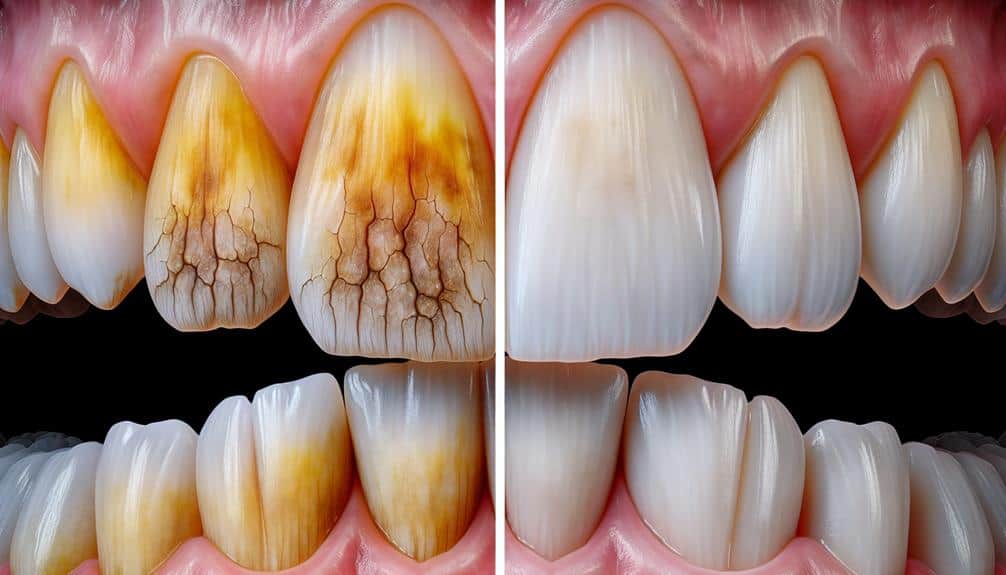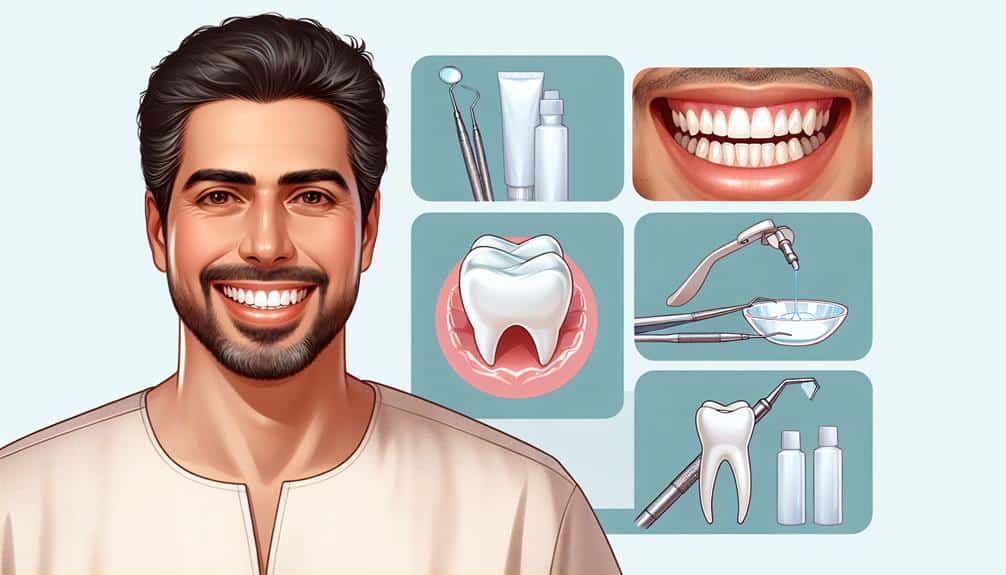Wondering about why your teeth stain with age? Pigmented foods, smoking, and thinning enamel contribute to discoloration. Aging exposes yellow dentin and allows stains to seep in easier. Acid erosion and poor oral care also play a significant role. Professional laser treatment and bleaching effectively whiten teeth. DIY remedies like baking soda and hydrogen peroxide can help. Maintain whiter teeth by brushing, flossing, and avoiding staining foods. Regular dental visits are essential. Understanding these causes and remedies can keep your smile bright.
Key Points
- Dentin exposure from thinning enamel causes yellowish discoloration with age.
- Natural changes in dentin color occur due to stain accumulation over time.
- Acid erosion weakens enamel, making it easier for stains to penetrate teeth.
- Tobacco use can lead to stubborn teeth stains that worsen with time.
- Professional whitening treatments like laser and bleaching are effective for removing stains.
Lifestyle Habits Impacting Tooth Stains
Regular consumption of highly pigmented foods and beverages can greatly contribute to the discoloration of your teeth. Diet choices play a significant role in the staining of your teeth. Foods like berries, beets, and drinks such as coffee and red wine contain strong color pigments that can adhere to the enamel, leading to stains over time. Additionally, smoking is a major culprit in teeth discoloration. The nicotine and tar present in cigarettes not only harm your overall health but also leave stubborn stains on your teeth.
Maintaining good oral hygiene practices is important in preventing tooth discoloration. Brushing and flossing regularly can help remove surface stains and prevent plaque buildup, which can contribute to further discoloration. However, it's vital to note that genetics also play a role in how prone you're to teeth staining. Some individuals may naturally have teeth that are more susceptible to discoloration, regardless of their lifestyle habits.
Understanding Aging Teeth Discoloration
Aging teeth discoloration is a natural process that occurs as enamel wears down over time, revealing the underlying dentin layer which tends to yellow with age. To understand the causes and prevention of teeth discoloration associated with aging, consider the following:
- Dentin Exposure: As enamel thins, the yellowish dentin layer becomes more visible.
- Changes in Dentin: The dentin naturally yellows with age due to the accumulation of stains.
- Acid Erosion: Acids from foods and drinks can weaken enamel, making it easier for stains to penetrate.
- Tobacco Use: Smoking or chewing tobacco can lead to stubborn teeth stains over time.
- Poor Oral Hygiene: Inadequate brushing and flossing can allow plaque and stains to build up on teeth.
While aging teeth discoloration is inevitable, there are natural remedies and preventive measures that can help minimize its effects. Regular dental cleanings, consuming teeth-friendly foods, and using whitening toothpaste can assist in maintaining a bright smile as you age.
Professional Whitening Treatments Available
Professional whitening treatments offer effective solutions for removing stubborn teeth stains and enhancing the brightness of your smile. When it comes to professional whitening, there are two main options that are commonly used: laser treatment and bleaching.
Laser treatment involves the use of a special light to activate the whitening agent applied to your teeth, accelerating the whitening process. This method is known for its quick results and efficiency in targeting deep stains.
On the other hand, bleaching options utilize peroxide-based whitening agents to break down stains on the surface and within the enamel of your teeth. This can be done in-office by a dental professional or through at-home kits prescribed by your dentist.
Both laser treatment and bleaching are safe and effective ways to achieve a brighter smile. It's essential to consult with your dentist to determine the most suitable whitening treatment based on your individual needs and the level of discoloration present on your teeth.
DIY Remedies for Teeth Stains
To tackle teeth stains at home, consider exploring DIY remedies that can help enhance the appearance of your smile. Here are some natural remedies and homemade solutions you can try:
- Baking Soda: Create a paste using baking soda and water to gently scrub away surface stains.
- Hydrogen Peroxide: Use a diluted hydrogen peroxide solution as a mouthwash to help whiten teeth.
- Strawberries: Mash up strawberries and apply the paste to your teeth for a natural whitening effect due to their malic acid content.
- Oil Pulling: Swish coconut oil around in your mouth to reduce bacteria and plaque that can cause staining.
- Apple Cider Vinegar: Dilute apple cider vinegar with water and use it as a mouthwash to help remove stains, but be cautious as it's acidic and shouldn't be used too frequently.
These natural remedies can be effective in addressing minor teeth stains. However, it's crucial to use them cautiously and not excessively, as some may have abrasive or acidic properties that can harm your teeth if used inappropriately.
Maintenance Tips for Whiter Teeth
For maintaining whiter teeth, implementing consistent oral hygiene practices is vital to prevent staining and discoloration. Diet choices play a significant role in the color of your teeth. Avoiding foods and beverages that are known to cause staining, such as coffee, tea, red wine, and dark berries, can help maintain the whiteness of your teeth. Opt for a diet rich in fruits and vegetables that can help scrub away plaque and surface stains naturally.
In addition to diet choices, practicing good oral hygiene is essential for keeping your teeth white. Brush your teeth at least twice a day with a fluoride toothpaste, floss daily to remove plaque and prevent stains between teeth, and use mouthwash to kill bacteria that can lead to discoloration. Regular dental check-ups and professional cleanings can also help remove stubborn stains and keep your teeth looking bright. By incorporating these maintenance tips into your daily routine, you can enjoy a whiter and brighter smile for years to come.
Frequently Asked Questions
Can Genetics Play a Role in the Development of Tooth Stains?
Genetics greatly influence the impact on tooth enamel. Understanding how your genes play a part in the development of tooth stains is essential. Explore how genetic factors can contribute to the formation of discoloration.
What Are Some Lesser-Known Factors That Can Contribute to Teeth Discoloration?
To maintain white teeth, consider your diet habits and lifestyle choices. Environmental factors and dental hygiene also play a role in teeth discoloration. Brush regularly, avoid staining foods, and seek professional cleanings for a brighter smile.
Are There Any Natural Remedies for Removing Tough Tooth Stains?
Seeking natural remedies to address stubborn tooth stains? Herbal remedies like baking soda and homemade whitening with activated charcoal can be effective. However, guarantee safety by consulting with your dentist before giving them a try.
How Often Should Professional Whitening Treatments Be Done to Maintain Results?
For long term effectiveness, professional whitening treatments should be done every 6-12 months. Consistent home care like brushing twice daily, flossing, and avoiding staining foods can help maintain results between treatments.
Can Certain Medications or Medical Conditions Affect the Color of Teeth?
Certain medications and medical conditions can indeed impact the color of your teeth. Factors like dietary habits, lifestyle choices, and aging processes, along with environmental influences, can contribute to changes in tooth color over time.



